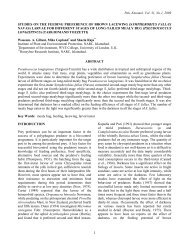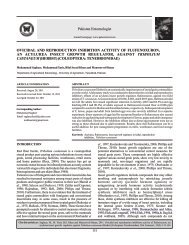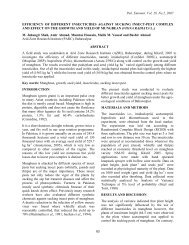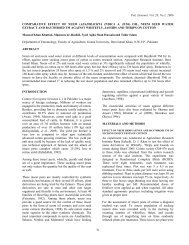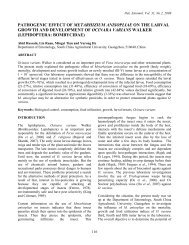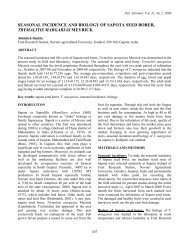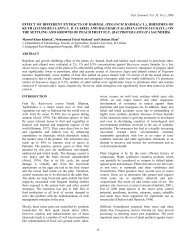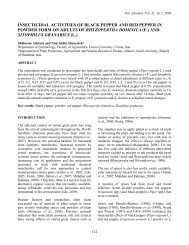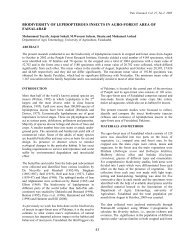Laboratory evaluation of chlorpyrifos, bifenthrin, imidacloprid ...
Laboratory evaluation of chlorpyrifos, bifenthrin, imidacloprid ...
Laboratory evaluation of chlorpyrifos, bifenthrin, imidacloprid ...
You also want an ePaper? Increase the reach of your titles
YUMPU automatically turns print PDFs into web optimized ePapers that Google loves.
Pak. Entomol. Vol. 28, No.2, 2006<br />
LABORATORY EVALUATION OF CHLORPYRIFOS, BIFENTHRIN, IMIDACLOPRID,<br />
THIAMETHOXAM AND FLUFENOXURON AGAINST MICROTERMES OBESI (ISOPTERA:<br />
TERMITIDAE)<br />
Sohail Ahmed and Muhammad Farhan<br />
Department <strong>of</strong> Agri. Entomology, University <strong>of</strong> Agriculture, Faisalabad<br />
ABSTRACT<br />
<strong>Laboratory</strong> <strong>evaluation</strong> <strong>of</strong> <strong>chlorpyrifos</strong> 40 EC, <strong>bifenthrin</strong> 10 EC, <strong>imidacloprid</strong> 50 SC, thiamethoxam 70WS<br />
and flufenoxuron 10 DC on mortality <strong>of</strong> Microtermes obesi in soils from Faisalabad, Layyah and Chakwal<br />
was carried out. Termites collected from sugarcane fields were exposed to the soil treated with various<br />
concentrations <strong>of</strong> the insecticides and mortality <strong>of</strong> the termites was observed until all the exposed<br />
individuals were dead. There was no difference in mortalities expressed as LT 50 in min and hrs in three<br />
soils. Mortality decreased with decrease in concentrations <strong>of</strong> the insecticides. Topical application showed<br />
the similar trend as was observed in the method <strong>of</strong> insecticide mixed soil.<br />
INTRODUCTION<br />
Fungus growing termites <strong>of</strong> the family Termitidae<br />
are the most troublesome in agricultural crops. They<br />
feed on the dead organic material such as crop<br />
residues, mulches and soil organic matter (humus)<br />
(Anonymous, 2001a). Termite’s fauna <strong>of</strong> Pakistan<br />
consists <strong>of</strong> 50 species, <strong>of</strong> these nine termite species<br />
belonging to Termitidae were recorded as pests <strong>of</strong><br />
agricultural crops in Pakistan. Microtermes obesi<br />
and Eremotermes paradoxalis were found damaging<br />
the sugarcane fields at Gojra, Lahore, and Qaderpur<br />
in Punjab (Akhtar and Shahid, 1993).<br />
Despite many safe and simple practices <strong>of</strong> termites’<br />
management including cultural and biological<br />
control, queen removal, plant resistance natural<br />
products physical barriers and baiting systems being<br />
proposed but insecticides are still plying a key role<br />
for the termites control. Chemicals like <strong>chlorpyrifos</strong>,<br />
thiodan cypermethrin, carbosulfan and triazophos<br />
have been recommended (Kumawat, 2001; Rana et<br />
al. 2001). Imidacloprid, thiamethoxam, fipronil and<br />
<strong>bifenthrin</strong> in different formulations have been found<br />
effective for the control <strong>of</strong> different species <strong>of</strong><br />
termites (Annonymous, 2001 a, b; Delgarde et al.,<br />
2002a,b; Singh and Singh, 2002; Ahmed et al.,<br />
2005a,b; Remmen and Su, 2005).<br />
The major constraint in termites’ management<br />
through these new chemicals appears to be whether<br />
are these effective in all situation and on various<br />
type <strong>of</strong> soils.<br />
Hu (2005) demonstrated a delayed mode <strong>of</strong> activity<br />
and nonrepellency <strong>of</strong> indoxacarb and fipronil against<br />
the two termite species Reticulitermes flavipes<br />
(Kollar) and Coptotermes formosanus Shiraki. There<br />
is no published information about the use <strong>of</strong><br />
<strong>imidacloprid</strong>, thiamethoxam and flufenoxuron as<br />
soil application in Pakistan.<br />
The present studies evaluated laboratory efficacy <strong>of</strong><br />
<strong>chlorpyrifos</strong> 40 EC, <strong>bifenthrin</strong> 10 EC, <strong>imidacloprid</strong><br />
50 SC, thiamethoxam 70WS and flufenoxuron 10<br />
DC on mortality <strong>of</strong> Microtermes obesi in soils from<br />
Faisalabad, Layyah and Chakwal.<br />
MATERIALS AND METHODS<br />
Collection <strong>of</strong> termites<br />
Subterranean termites (M. obesi) were collected<br />
from the agricultural fields in and around the campus<br />
<strong>of</strong> University <strong>of</strong> Agriculture, Faisalabad. Workers <strong>of</strong><br />
each species <strong>of</strong> at least 3rd instar (as determined by<br />
size) were collected within 3 days <strong>of</strong> the beginning<br />
<strong>of</strong> the experiment.<br />
Research work was carried out in the Termites<br />
Management <strong>Laboratory</strong>, Department <strong>of</strong> Agri.<br />
Entomology, University <strong>of</strong> Agriculture, Faisalabad.<br />
45
Pak. Entomol. Vol. 28, No.2, 2006<br />
Insecticides<br />
Following five insecticides were used in the<br />
bioassay <strong>of</strong> termites,<br />
1. Chlorpyrifos 40EC<br />
2. Bifenthrin 10EC<br />
3. <strong>imidacloprid</strong> 50SL<br />
4. Thiamthoxam 70WSC<br />
5. Flufenoxuron 10DC<br />
1000 ppm, 500 ppm, 250 ppm, 125 ppm, 62.5 ppm,<br />
31.25 ppm, 15.62 ppm and 7.81 ppm solutions <strong>of</strong><br />
these insecticides were prepared in order to evaluate<br />
their effects against Microtermes obesi.<br />
Soil sampling<br />
Soil samples from 3 Districts (Faisalabad, Layyah<br />
and Chakwal) were collected. The soil was sifted<br />
through a 30-mesh screen and moisture was<br />
determined with the help <strong>of</strong> Oven Wet and dry<br />
method. More amount <strong>of</strong> water was added up to 50%<br />
<strong>of</strong> water holding capacity <strong>of</strong> soil to avoid mortality<br />
<strong>of</strong> termites due to dehydration.<br />
Two types <strong>of</strong> bioassay were carried out.<br />
a. Mixing insecticide concentrations in soil<br />
Toxicity tests were done in Petri dishes <strong>of</strong> 8.75 cm<br />
dia containing 10g sifted soil, strips <strong>of</strong> sugarcane<br />
having dimension 1.5 x 6 cm. were placed in each<br />
Petri plate to keep the termites alive. Experimental<br />
units were oven dried for 24 h for solvent<br />
evaporation. Control units were treated with acetone<br />
only. 40 workers <strong>of</strong> termites were released in the<br />
Petri dishes having treated and untreated soils. These<br />
dishes were placed under controlled conditions<br />
28 + 2 0 C and 80 + 5% r.h. in a growth chamber.<br />
Termites were examined after every 2 hours up to 12<br />
hours, later, and then after each 24 hours until 100%<br />
mortality occurred.<br />
b. Direct exposure by Micro applicator<br />
0.1 µl (microlitre) drop <strong>of</strong> different concentrations<br />
was applied to the thorax <strong>of</strong> the termites by using<br />
Burkard Micro Applicator. The termites after<br />
treatment were put into the Petri dishes containing<br />
filter paper moistened with distilled water. Mortality<br />
was noted after 24 hours <strong>of</strong> treatment.<br />
Statistical Analysis<br />
Probit analysis (Polo-Pc) was used to make<br />
toxicological inferences.<br />
RESULTS<br />
Table 1 shows LT 50 values <strong>of</strong> different<br />
concentrations <strong>of</strong> <strong>chlorpyrifos</strong>, <strong>bifenthrin</strong>,<br />
<strong>imidacloprid</strong> and thiamethoxam on Microtermes<br />
obesi in soils from Faisalabad, Chakwal and Layyah.<br />
LT 50 values <strong>of</strong> different concentrations <strong>of</strong><br />
<strong>chlorpyrifos</strong> and <strong>bifenthrin</strong> were in minutes while<br />
<strong>imidacloprid</strong> and thiamethoxam showed LT 50 values<br />
in hours. These values increased with decline in<br />
concentrations. However, small difference was<br />
found in LT 50 values <strong>of</strong> four insecticides in three<br />
soils. For example, 198, 222 and 227 min were<br />
values at 7.81 ppm <strong>of</strong> <strong>chlorpyrifos</strong> in soils from<br />
Faisalabad, Chakwal and Layyah. Bifenthrin<br />
differed from <strong>chlorpyrifos</strong> as 222, 136 and 123 were<br />
values in these soils. There was no difference in<br />
LT 50 values <strong>of</strong> <strong>imidacloprid</strong> and thiamethoxam in<br />
three soil types.<br />
Topical application <strong>of</strong> different concentrations <strong>of</strong><br />
<strong>chlorpyrifos</strong>, <strong>bifenthrin</strong>, <strong>imidacloprid</strong> and<br />
thiamethoxam did not show difference in LT 50<br />
values recorded in case <strong>of</strong> when these were applied<br />
in the soils. To some extent these values were less in<br />
control treatment (Table 2).<br />
The lethal time <strong>of</strong> flufenoxuron to kill 50%<br />
population <strong>of</strong> Microtermes obesi was high (3.62 to<br />
11) as Chakwal than at two other places (2.5 to 7).<br />
However direct exposure to flufenoxuron showed<br />
similar pattern as was observed in case <strong>of</strong> other four<br />
insecticides (Table 3).<br />
46
Pak. Entomol. Vol. 28, No.2, 2006<br />
Table 1. LT 50 values <strong>of</strong> different concentrations <strong>of</strong> <strong>chlorpyrifos</strong>, <strong>bifenthrin</strong>, <strong>imidacloprid</strong> and<br />
thiamethoxam on M. obesi in soils from Faisalabad, Chakwal and Layyah<br />
<strong>chlorpyrifos</strong> <strong>bifenthrin</strong> <strong>imidacloprid</strong> thiamethoxam<br />
Mins. Mins. Hrs Hrs.<br />
Faisalabad<br />
C 1 (1000 ppm) 9 10 1.17 2.39<br />
C 2 (500 ppm) 13 17 1.81 2.61<br />
C 3 (250 ppm) 19 22 2.41 4.10<br />
C 4 (125 ppm) 33 30 3.48 5.81<br />
C 5 (62.5 ppm) 66 69 5.33 6.89<br />
C 6 (31.25 ppm) 118 105 8.11 8.38<br />
C 7 (15.62 ppm) 175 154 10.3 11.5<br />
C 8 (7.81 ppm) 198 222 11.7 17.9<br />
C 9 (Control) 251 298 232 298<br />
Chakwal<br />
C 1 (1000 ppm) 10 15 1.26 2<br />
C 2 (500 ppm) 17 20 1.73 2.63<br />
C 3 (250 ppm) 22 26 2.47 3.63<br />
C 4 (125 ppm) 30 34 3.66 4.92<br />
C 5 (62.5 ppm) 69 44 5.71 5.43<br />
C 6 (31.25 ppm) 105 54 7.32 8<br />
C 7 (15.62 ppm) 154 94 9.35 10<br />
C 8 (7.81 ppm) 222 136 11.2 14<br />
C 9 (Control) 298 221 276 222<br />
Layyah<br />
C 1 (1000 ppm) 11 15 1.38 1.85<br />
C 2 (500 ppm) 13 25 1.97 2.67<br />
C 3 (250 ppm) 20 28 2.71 3.09<br />
C 4 (125 ppm) 29 39 3.63 3.56<br />
C 5 (62.5 ppm) 59 45 5.77 4.38<br />
C 6 (31.25 ppm) 90 54 8.92 6.05<br />
C 7 (15.62 ppm) 138 105 11.3 9.27<br />
C 8 (7.81 ppm) 227 123 14.2 10.6<br />
C 9 (Control) 289 266 245 274<br />
Table 2. LT 50 values <strong>of</strong> <strong>chlorpyrifos</strong>, <strong>bifenthrin</strong>, <strong>imidacloprid</strong> and thiamethoxam for M. obesi<br />
workers by direct exposure<br />
Concentrations <strong>chlorpyrifos</strong> <strong>bifenthrin</strong> Imidacloprid thiamthoxam<br />
Mins, Mins. Hrs Hrs<br />
C 1 (1000 ppm) 7 13 1.50 1.15<br />
C 2 (500 ppm) 10 18 2.21 1.66<br />
C 3 (250 ppm) 13 27 3.21 2.41<br />
C 4 (125 ppm) 19 40 6.34 3.45<br />
C 5 (62.5 ppm) 33 57 8.41 5.04<br />
C 6 (31.25 ppm) 53 76 10.4 6.89<br />
C 7 (15.62 ppm) 66 100 27.9 8.21<br />
C 8 (7.81 ppm) 79 140 31.8 9.00<br />
C 9 (Control) 195 149 132 133<br />
47
Pak. Entomol. Vol. 28, No.2, 2006<br />
Table 3. LT 50 values (hrs) <strong>of</strong> different concentrations <strong>of</strong> flufenoxuron 10 DC for M. obesi in treated<br />
soil and in direct exposure<br />
Soil<br />
Concentrations Faisalabad Chakwal Layyah<br />
C 1 (1000 ppm) 2.51 3.62 2.85 1.32<br />
C 2 (500 ppm) 3.23 5.10 3.48 1.80<br />
C 3 (250 ppm) 4.73 7.26 4.45 2.37<br />
C 4 (125 ppm) 7 11 6.37 3.60<br />
C 5 (Control) 98 133 132 132<br />
Direct exposure<br />
DISCUSSION<br />
Chlorpyrifos 40 EC at 1000 ppm was found to be the<br />
most effective insecticide against M. obesi with LT 50<br />
ranging between 9 to 15 min in all the soils. The<br />
LT 50 increases with the decrease in concentration.<br />
Our results are in confirmation with the results <strong>of</strong> Su<br />
et al. (1987) who stated that mortality <strong>of</strong> termites<br />
exposed to <strong>chlorpyrifos</strong> 40 EC typically occurred<br />
within the first 24h <strong>of</strong> exposure. No penetration was<br />
observed in all the concentrations <strong>of</strong> <strong>chlorpyrifos</strong> 40<br />
EC. Su et al. (1995) reported that the termite species<br />
did not penetrate sand containing more > 100ppm <strong>of</strong><br />
<strong>chlorpyrifos</strong> 40 EC. Su and Scheffrahn (1990)<br />
reported that termite did not fully penetrate the<br />
treated sand at high concentration due to high<br />
mortality. Bifenthrin 10EC was not penetrated by<br />
Reticulitermes flavipes at any thickness through the<br />
sand treated with 1ppm (Hu, 2005). Imidcloprid<br />
50SL and thiamethoxam 70WS caused the mortality<br />
in M. obesi but their efficacy did not match with<br />
<strong>chlorpyrifos</strong> 40 EC and <strong>bifenthrin</strong> 10EC.<br />
Imidachloprid 50SL was more efficient than<br />
thiamethoxam 70WP and flufenoxuron 10DC. These<br />
results are in agreement to that <strong>of</strong> Almeida and<br />
Alves (1999) who reported that <strong>imidacloprid</strong> had<br />
better efficacy against termites. However, Remmen<br />
and Su (2005) reported that actara 70WS was found<br />
to be more toxic against C. formosanus and<br />
Reticulitermes flavipes. Cascade 10DC was found to<br />
be least effective for the control <strong>of</strong> termites,<br />
nevertheless, at high concentration no penetration<br />
was observed but at lower concentration the termite<br />
species penetrated into the soil.<br />
Topical application <strong>of</strong> the insecticides on the<br />
termites showed the following order <strong>of</strong> efficacy:<br />
<strong>chlorpyrifos</strong> > <strong>bifenthrin</strong> > flufenoxuron ><br />
thiamethoxam > <strong>imidacloprid</strong>.<br />
In nutshell, it is nearly difficult to achieve a<br />
homogenous concentration <strong>of</strong> these insecticides in<br />
the soil. It is unknown how these treatments may<br />
affect field population <strong>of</strong> termites. Future<br />
investigations include field studies to determine<br />
application <strong>of</strong> the insecticides per volume basis <strong>of</strong><br />
the soil.<br />
REFERENCES<br />
Ahmed, S., A. Naseer and S. Fiaz, 2005a.<br />
Comparative efficacy <strong>of</strong> botanicals and<br />
insecticides on termites in sugarcane at<br />
Faisalabad. Pak. Entomol., 27 (1): 23-26.<br />
Ahmed , S., M.A. Riaz and A. Hussain, 2005b.<br />
Comparative efficacy <strong>of</strong> Datura alba nees,<br />
Calotropis procera and <strong>imidacloprid</strong> on<br />
termites in sugarcane at Faisalabad. Pak.<br />
Entomol., 27 (2): 11-14.<br />
Akhtar, M.S. and A.S. Shahid, 1993. Termites as<br />
pest <strong>of</strong> agricultural crops in Pakistan. Pak. J.<br />
Zool., 25 (3): 187-193.<br />
Almeida, J.M. and S.B. Alves. 1999. Control <strong>of</strong> the<br />
subterranean termites Heterotermes tenuis<br />
(Hagen) (Isoptera: Rhinotermitidae) in<br />
sugarcane with termitrap ® baits associated<br />
with Beauveria bassiana (Bals) and<br />
insecticides in dry conditions. Arquivos-do-<br />
Instituto-siologico-sao-Pavlo, 66 (2): 85-90.<br />
Anonymous, 2001a. HDRA the organic<br />
organization: Ryton organic gardens<br />
Coventry CV8, 3LG, UK.<br />
Anonymous, 2001b. Chemical control <strong>of</strong><br />
Microtermes obesi and Odontotermes<br />
obesus (termites) in sugarcane. Ann. Rept.<br />
Ayub Agric. Res. Instt. Faisalabad, Pakistan.<br />
pp.39-40.<br />
48
Pak. Entomol. Vol. 28, No.2, 2006<br />
Anonymous, 2001c. Effect <strong>of</strong> Chlorpyrifos 40 EC,<br />
Bifenthrin 10EC, Furadan 3G on termite<br />
population in mango orchards.Ann. Rept.<br />
Ayub Agric. Res. Instt. Faisalabad, Pakistan,<br />
pp:80-8.<br />
Delgarde, S. and C.Rouland-Lefevre, 2002a.<br />
Evaluation <strong>of</strong> the effects <strong>of</strong> thiamethoxam<br />
on three species <strong>of</strong> African termite (Isoptera:<br />
Termitidae) crop pests. J. Econ. Entomol.,<br />
95 (3):531-536.<br />
Delgarde, S. and C.Rouland-Lefevre, 2002b.<br />
Efficacy <strong>of</strong> Actara registered 25WG on<br />
Three Species <strong>of</strong> Brazilian Termite<br />
(Isoptera: Nasutitermitinae) Crop Pests.<br />
Sociobiol., 40 (3): 699-710.<br />
Hu, X.P., 2005. Valuation <strong>of</strong> efficacy and<br />
nonrepellency <strong>of</strong> indoxacarb and fiproniltreated<br />
soil at various concentrations and<br />
thicknesses against two subterranean<br />
termites (Isoptera: Rhinotermitidae). J.<br />
Econ. Entomol., 98(2):509-17.<br />
Kumawat, K.C., 2001. Evaluation <strong>of</strong> some<br />
insecticides field termites, Odontotermes<br />
obesus and Microtermes obesi in wheat,<br />
Triticum aestivum. Ann. Pl. Protect. Sci., 9<br />
(1): 51-53.<br />
Rana, J., S. Ombir and K.K. Dahiya, 2001.<br />
Management <strong>of</strong> termite, Microtermes obesi<br />
(Holmgren) in wheat, T. aestivum through<br />
seed treatment. Ann. Bio., 17 (2): 207-209.<br />
Remmen, N.L. and N.Y. Su, 2005. Tunneling and<br />
Mortality <strong>of</strong> Eastern and Formosan<br />
Subterranean Termites (Isoptera:<br />
Rhinotermitidae) in Sand Treated with<br />
Thiamethoxam or Fipronil. J. Econ.<br />
Entomol., 98(3): 906-910.<br />
Singh, S.K. and G. Singh, 2002. Comparative<br />
<strong>evaluation</strong> <strong>of</strong> chemical and botanical<br />
insecticides against termites. Entomol., 27<br />
(2): 153-160.<br />
Su, N.Y. and R.H. Scheffrahn. 1990. Comparison <strong>of</strong><br />
eleven soil termiticides against the<br />
Formosan Subterranean termite and eastern<br />
subterranean termites (Isoptera:<br />
Rhinotermitidae). J. Econ. Entomol., 83:<br />
1918-1924.<br />
Su, N.Y., M. Tamashiro and M.I. Haverty, 1987.<br />
Characterization <strong>of</strong> slo-acting insecticides<br />
for the remedial control <strong>of</strong> the Formosan<br />
subterranean termite (Isoptera:<br />
Rhinotermitidae). J. Econ. Entomol., 80:<br />
1-4.<br />
Su, N.Y., G.S. Wheeler and R.H. Scheffrahn, 1995.<br />
Subterranean termite (Isoptera:<br />
Rhinotermitidae) penetration into sand<br />
treated at various thicknesses with<br />
termiticides. J. Econ. Entomol., 88(6): 1690-<br />
1694.<br />
49
50<br />
Pak. Entomol. Vol. 28, No.2, 2006



